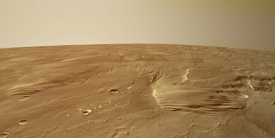Where the Wind Has an Edge
One of the most enigmatic geologic units on Mars is the Medusae Fossae formation. Made up of four individual areas, it sprawls for more than 5,000 kilometers (3,000 miles) along the boundary between the cratered southern highlands and the lowland plains to the north, and between the volcanic centers of Tharsis and Elysium.
Scientists have puzzled over the formation's origin, age, and nature since it was first studied in detail in the late 1970s.
The formation is lightly cratered, which points to a geologically young age. It shows many surface features produced by wind, suggesting it is made of soft, fine-grained, and easily eroded materials. And much to scientists' surprise, in the early 1990s Earth-based radar found it reflects almost no radar signals, earning it the nickname of "Stealth."
Memnonia Sulci, the area shown in this image, lies within one of the formation's four units. This scene is some 730 km (450 mi) northeast of the Mars Exploration Rover Spirit in Gusev Crater. Memnonia displays several of the Medusae Fossae formation's most characteristic features.
The image is a mosaic of daytime infrared frames taken by the Thermal Emission Imaging System (THEMIS), a camera operating with 10 infrared bands and five visual ones on NASA's Mars Odyssey orbiter.
Sweeping around Mars onboard Odyssey since 2002, THEMIS has woven a tight network of images that now cover the planet at 100-meter (330-foot) resolution. THEMIS has also imaged selected regions at 18-meter (59 feet) resolution using its visual-wavelength imager.
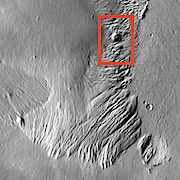 Wind Like a Knife
Wind Like a Knife
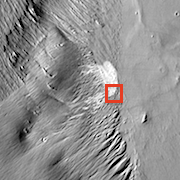 Dark Ground
Dark Ground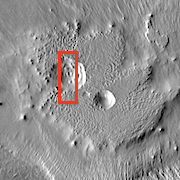 Dust Pit
Dust Pit
Vital Statistics
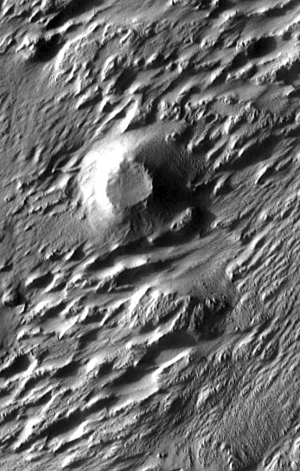
Wind Like a Knife
When this impact crater formed, the blast threw out debris that has covered the ground all around. This slowed erosion and left the crater as a knob, full to the brim with wind-blown sediments. This image, about 6 km wide, is part of THEMIS VIS frame V27090004.
NASA/JPL-Caltech/Arizona State University
Download Original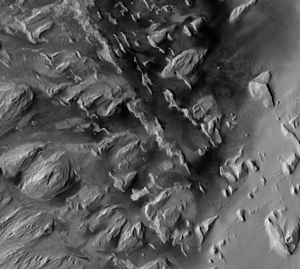
Dark Ground
As the soft material erodes, dark patches emerge into view between the hills. These may be areas of loose dark sand or exposed basalt bedrock. This image, 2.5 km wide, is part of image PSP_006273_1715 taken by the HiRISE camera on Mars Reconnaissance Orbiter.
NASA/JPL-Caltech/University of Arizona
Download Original
Dust Pit
An old crater is being slowly exhumed by the wind. At least two and perhaps three layers are visible within the crater. These presumably represent episodes in which the Medusae Fossae formation accumulated additional sheets of ash or ignimbrite. Dark streaks running down the slopes show some material is loose and on the move even today. Such streaks remain visible until fresh dust falling from the air lightens the ground, a process that takes only a few months to a year. This image, 3.7 km wide, is part of image ESP_016215_1730 taken by the HiRISE camera on Mars Reconnaissance Orbiter.
NASA/JPL-Caltech/University of Arizona
Download Original